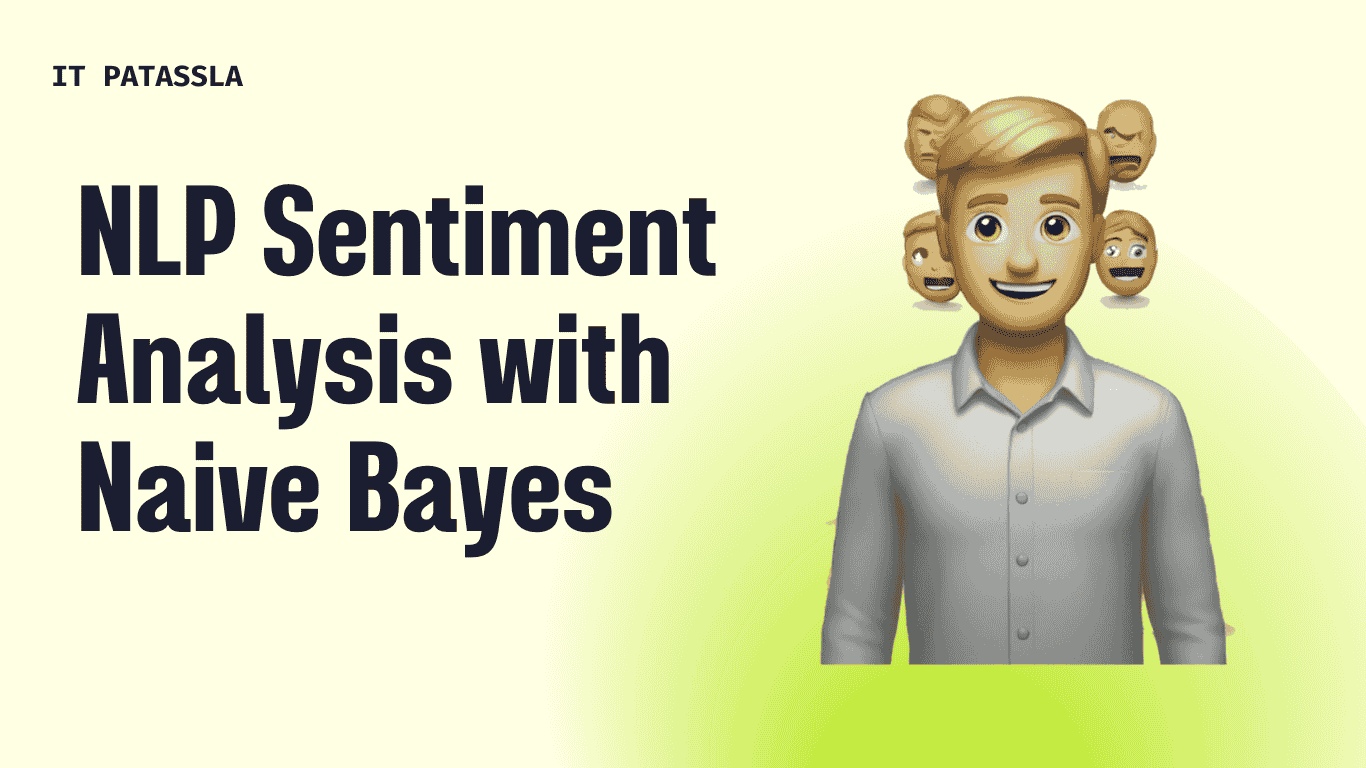NLP Sentiment Analysis with Naive Bayes Best Guide 2025
🧠 NLP Sentiment Analysis with Naive Bayes: A Beginner-Friendly Guide
As our world becomes increasingly data-driven, analyzing opinions, feelings, and customer feedback has become essential. Sentiment analysis, powered by Natural Language Processing (NLP), helps businesses and developers unlock insights from text.
But how exactly does sentiment analysis work? One of the most effective and beginner-friendly models is the Naive Bayes algorithm.
In this post, you’ll learn:
- What sentiment analysis is
- How Naive Bayes works in NLP
- The steps to implement it using Python
- Real-world use cases and examples
- Benefits, limitations, and alternatives
Let’s dive into how this powerful combination of NLP + Naive Bayes is transforming industries.
📚 What Is Sentiment Analysis?
Sentiment analysis (also known as opinion mining) is the process of identifying and categorizing emotions in text. It helps determine whether a piece of writing expresses a positive, negative, or neutral sentiment.
🔍 Why Use Sentiment Analysis?
- Monitor brand reputation
- Track product reviews
- Analyze political opinions
- Understand user feedback
- Detect customer satisfaction in real time
📌 Real-Life Examples of Sentiment Analysis
- Twitter Sentiment Tracking – Companies analyze tweets to detect public reactions to product launches or campaigns.
- Movie Reviews – Sites like IMDb and Rotten Tomatoes use sentiment analysis to summarize audience feedback.
- E-commerce Reviews – Platforms like Amazon auto-summarize buyer sentiments to highlight common pros and cons.
🧠 Introduction to Naive Bayes in NLP
Naive Bayes is a supervised machine learning algorithm based on Bayes’ Theorem with the “naive” assumption of independence between features.
Despite its simplicity, it is highly effective for text classification tasks, especially sentiment analysis.
📘 What Is Bayes’ Theorem?
Bayes’ Theorem is defined as:
P(A|B) = [P(B|A) * P(A)] / P(B)
In NLP terms:
- A: The class (e.g., positive or negative sentiment)
- B: The observed features (e.g., words in a review)
- P(A|B): Probability that a given text belongs to class A based on evidence B
🤖 Why Use Naive Bayes for Sentiment Analysis?
- Fast and scalable
- Works well with small datasets
- Great for text classification
- Easy to implement and interpret
🧰 Types of Naive Bayes Algorithms
- Multinomial Naive Bayes – Best suited for discrete features like word counts (used in sentiment analysis)
- Bernoulli Naive Bayes – Binary features (word exists or not)
- Gaussian Naive Bayes – For continuous values (less common in NLP)
🛠️ How Sentiment Analysis with Naive Bayes Works
🗂️ Step 1: Collect Text Data
Gather labeled text data. For example:
| Review | Sentiment |
|---|---|
| “The movie was great!” | Positive |
| “Terrible acting and boring.” | Negative |
Datasets you can use:
- IMDb Movie Reviews
- Twitter Sentiment Analysis Dataset
- Amazon Product Reviews
🔤 Step 2: Text Preprocessing
Before feeding text into the model, clean and prepare it:
- Lowercase the text
- Remove punctuation and numbers
- Remove stop words (e.g., is, the, and)
- Perform stemming or lemmatization
- Tokenize the text
🧮 Step 3: Feature Extraction
Convert text into numerical form using:
- Bag of Words (BoW)
- TF-IDF (Term Frequency-Inverse Document Frequency)
This creates a matrix where rows are documents and columns are words.
🧪 Step 4: Train the Naive Bayes Model
Split your dataset:
- 80% training
- 20% testing
Use Python libraries like scikit-learn:
from sklearn.naive_bayes import MultinomialNB
from sklearn.feature_extraction.text import CountVectorizer
from sklearn.model_selection import train_test_split
# Sample text data
texts = ["Good movie", "Bad acting", "Fantastic plot", "Not worth watching"]
labels = ["positive", "negative", "positive", "negative"]
# Convert text to features
vectorizer = CountVectorizer()
X = vectorizer.fit_transform(texts)
# Split
X_train, X_test, y_train, y_test = train_test_split(X, labels, test_size=0.25)
# Train model
model = MultinomialNB()
model.fit(X_train, y_train)
# Predict
print(model.predict(X_test))
📊 Step 5: Evaluate the Model
Use evaluation metrics:
- Accuracy
- Precision and Recall
- Confusion Matrix
- F1 Score
Example:
from sklearn.metrics import accuracy_score
predictions = model.predict(X_test)
print("Accuracy:", accuracy_score(y_test, predictions))
🌐 Real-World Applications
🛍️ E-commerce Review Mining
Amazon and Flipkart use sentiment analysis to:
- Rank reviews
- Highlight key positive/negative comments
- Personalize product recommendations
🧾 Banking and Finance
Banks use Naive Bayes for:
- Identifying sentiment in customer complaints
- Monitoring social media mentions
- Risk sentiment detection in financial news
📰 News Sentiment Analysis
Journalism platforms analyze public mood about events, politics, and economy.
📱 Social Media Monitoring
Brands use tools like Brandwatch and Hootsuite Insights (which use Naive Bayes under the hood) to track user sentiment on platforms like X (Twitter), Instagram, and Reddit.
🎯 Advantages of Using Naive Bayes for NLP
- Speed – Fast to train and predict
- Simplicity – Easy for beginners to understand
- Efficiency – Performs well with high-dimensional data (text)
- Baseline model – Great for prototyping
⚠️ Limitations of Naive Bayes
- Assumes independent features, which may not hold in natural language
- Struggles with irony, sarcasm, and context
- Requires labeled data to train
- May misclassify neutral sentiments
🆚 Naive Bayes vs. Other Sentiment Analysis Models
| Model | Pros | Cons |
|---|---|---|
| Naive Bayes | Fast, interpretable | Ignores word dependencies |
| SVM | High accuracy | Slower to train |
| Logistic Reg. | Good for binary classification | May require feature scaling |
| Deep Learning | Context-aware, state-of-art | Complex, needs more data |
🧠 Tips to Improve Naive Bayes Accuracy
- Use bigram or trigram features (e.g., “not good”)
- Balance the dataset with equal positive and negative samples
- Apply TF-IDF for better weighting
- Use cross-validation to avoid overfitting
🔮 Future of Sentiment Analysis in NLP
With the rise of transformers like BERT and GPT, sentiment analysis is evolving. However, Naive Bayes still holds value, especially for:
- Small datasets
- Real-time applications
- Educational use
- Rapid prototyping
It remains an excellent entry point into the world of AI-powered text analytics.
✅ Final Thoughts: NLP Sentiment Analysis with Naive Bayes
If you’re starting your journey in NLP and want to build a project that gives instant results, Naive Bayes for sentiment analysis is your go-to algorithm.
It’s simple, efficient, and gives surprisingly powerful results, especially when paired with well-preprocessed text.
Whether you’re analyzing tweets, reviews, or emails—this classic model remains relevant and effective.
Also read these




